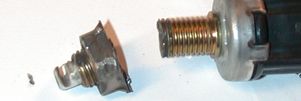|
Buy a 14mm "crowfoot" wrench; or, bend an offset into and shorten
- cut off - a 14mm open end wrench; or, bend an offset into, shorten and
cut a notch in box end the width of the brake light switch shaft into
a 14mm box end wrench. While you're out, buy some Kevlar gloves to protect
your hands from sheet metal cuts.
OK,OK you can tell we don't really like any of these ideas - why? Two
reasons: 1) pain and strain; and, 2) the average person can't fabricate
these things! We originally dismissed this option. Then people wrote us
to tell us about it. Most took at least a half-hour to remove the switch.
Many cursed and bled. At least one person couldn't get the nut to loosen
because the alignment of the nut and the clearances just didn't work.
Several people did it complete it successfully.
If you're going to go this route anyway, here's how you proceed:
First, disconnect the plug from the back of the existing switch. There
is a little release tab on the plug to press, and then pull the plug.
Do not pull on the wires.
Second, note how far the threaded shaft of the switch protrudes from
the welded on nut. Note also the clearance it has from the brake pedal
when the brake pedal is at rest. You will need to duplicate this alignment
with the new switch.
Now, with the short wrench, you should be able to reach up around the
back side of the sheet metal and get the wrench on the nut on that side.
You will have very little clearance and won't be able to turn it much.
But all you need is just a little turn to "unlock" the nut.
Then you can unscrew the switch by turning the switch body..
When you have the switch out, remove the nut on the shaft of the old
switch and put it the new switch, threading it down to the same position.
Install the new switch by reversing the above: Screw in the switch, make
sure the alignment of the switch is correct. Tighten the nut that is behind
the sheet metal down: fingers first, then with the wrench. Finally, plug
in the wire harness to the back of the switch.
|
